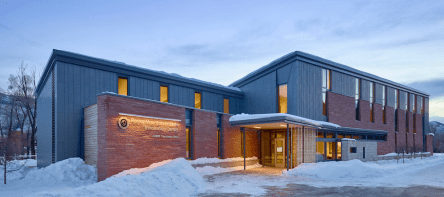Touted as the one of the nation’s most energy efficient structures, the Rocky Mountain Institute’s new headquarters doesn’t just survive Colorado’s harsh winters – it thrives. With nighttime temperatures hovering around 5 degrees Fahrenheit in the winter, and an average of 90 inches of snow per year, Basalt, Colorado may not seem like the ideal spot for one of the world’s most energy efficient buildings. That didn’t stop the Rocky Mountain Institute (RMI) from choosing a new location along the Basalt’s Roaring Fork River for their new headquarters. With neighbors like Aspen and Snowmass, RMI’s property shines like a beacon amidst snowcapped mountains and knee-high drifts, but it’s the 252 days of sunlight per year that help this architectural set piece maintain 60-degree indoor temperatures even during the coldest night of the year. The surrounding ski resorts actually helped inspire the building’s structure. As Justin Brooks, lead designer ZFG Architects explains in an interview with Gizmodo, “It’s a very Colorado Solution. If you’re wearing a down jacket that’s highly insulated on the back, you can still sit outside and enjoy a beer.” RMI’s building follows similar logic. The building capitalizes on all those sunny days by using airflow, directed ventilation and solar panels to capture the solar gain from the south side of the building – which gets the most direct exposure to sunlight – and use it to manage the temperature inside. Rooftop solar panels and high-performance quad-pane windows also do their part, the former contributing to the structure’s power load and the latter trapping thermal energy. The building’s exterior also contributes, with a “super tight” building envelope and sunshades on the façade that move based on weather sensor data. Kinetic and responsive, the outside of the building excels at controlling glare and...

